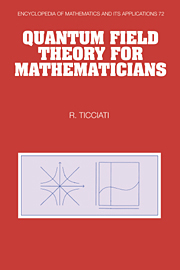Book contents
- Frontmatter
- Contents
- Preface
- Introduction
- 1 Relativistic Quantum Mechanics
- 2 Fock Space, the Scalar Field, and Canonical Quantization
- 3 Symmetries and Conservation Laws
- 4 From Dyson's Formula to Feynman Rules
- 5 Differential Transition Probabilities and Predictions
- 6 Representations of the Lorentz Group
- 7 Two-Component Spinor Fields
- 8 Four-Component Spinor Fields
- 9 Vector Fields and Gauge Invariance
- 10 Reformulating Scattering Theory
- 11 Functional Integral Quantization
- 12 Quantization of Gauge Theories
- 13 Anomalies and Vacua in Gauge Theories
- 14 SU(3) Representation Theory
- 15 The Structure of the Standard Model
- 16 Hadrons, Flavor Symmetry, and Nucleon-Pion Interactions
- 17 Tree-Level Applications of the Standard Model
- 18 Regularization and Renormalization
- 19 Renormalization of QED: Three Primitive Divergences
- 20 Renormalization and Preservation of Symmetries
- 21 The Renormalization Group Equations
- Appendix
- References
- Index
7 - Two-Component Spinor Fields
Published online by Cambridge University Press: 31 October 2009
- Frontmatter
- Contents
- Preface
- Introduction
- 1 Relativistic Quantum Mechanics
- 2 Fock Space, the Scalar Field, and Canonical Quantization
- 3 Symmetries and Conservation Laws
- 4 From Dyson's Formula to Feynman Rules
- 5 Differential Transition Probabilities and Predictions
- 6 Representations of the Lorentz Group
- 7 Two-Component Spinor Fields
- 8 Four-Component Spinor Fields
- 9 Vector Fields and Gauge Invariance
- 10 Reformulating Scattering Theory
- 11 Functional Integral Quantization
- 12 Quantization of Gauge Theories
- 13 Anomalies and Vacua in Gauge Theories
- 14 SU(3) Representation Theory
- 15 The Structure of the Standard Model
- 16 Hadrons, Flavor Symmetry, and Nucleon-Pion Interactions
- 17 Tree-Level Applications of the Standard Model
- 18 Regularization and Renormalization
- 19 Renormalization of QED: Three Primitive Divergences
- 20 Renormalization and Preservation of Symmetries
- 21 The Renormalization Group Equations
- Appendix
- References
- Index
Summary
The two two-dimensional representations of the Lorentz group give rise to left and right two-component spinor fields; on the basis of a thorough understanding of these representations, the procedure of perturbative canonical quantization developed for scalar fields can be applied to two-component spinor fields.
Introduction
Having classified the representations of the Lorentz group in the last chapter, this chapter returns to the theme of Chapter 4, namely perturbative canonical quantization. Here and in the two subsequent chapters, we extend the principles of Chapter 4 to two-component Fermi fields, four-component Fermi fields, and vector fields.
This chapter has a purpose to present the quantum theory of Weyl fields and make the connection between Weyl fields and Dirac fields. By the end of this chapter, we shall be able to compute scattering amplitudes for Feynman diagrams with external and internal Weyl lines.
We begin in Sections 7.1 and 7.2 by finding a convenient description of (0, 1/2) and (1/2, 0), the smallest non-trivial representations of the Lorentz group. These spinor representations respectively determine the right and left two-component spinor or Weyl fields. Section 7.3 then tabulates all the Lorentz-invariant Lagrangian terms which can be formed from these Weyl fields. The anti-symmetric character of these terms implies that the Weyl fields must be fermionic.
- Type
- Chapter
- Information
- Quantum Field Theory for Mathematicians , pp. 166 - 206Publisher: Cambridge University PressPrint publication year: 1999



